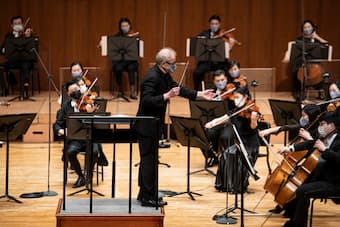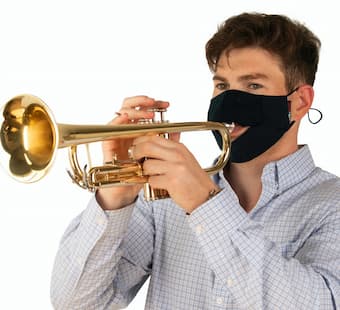GRADUAL RETURN
Now that live concerts are becoming more of a reality, I’ve been approached by several musicians about how to safely return to playing after a hiatus without injuring ourselves. It’s essential to return gradually. Begin with 10 minutes. It’s easy to forget how athletic playing is. Increase the number of practice sessions of 10 minutes before increasing the length of time—play 10 minutes, then two 10-minutes sessions (with a long break in between) then after several days, play three 10—minute segments before you increase to 15 or 20 minutes. Repeat.

SPO director Osmo Vänskä leads the orchestra during a livestreamed concert Friday at the Seoul Arts Center in southern Seoul. © SPO
Make certain you are sitting or standing with good posture. While sitting—your knees should descend from your hips. Maintain neutral or natural postures with a lumbar curve in your lower back, your shoulders down, your torso facing forward, your head upright, and your weight forward and on your feet. While standing—keep your knees slightly bent, your head erect, place one foot slightly more forward than the other, your shoulders down, your torso facing forward, and maintain a lumbar curve in your back. Be certain to avoid leaning backwards or overly arching your back.
NOT TOO HIGH, NOT TOO LOW; NOT TOO FAST, NOT TOO SLOW.
Begin gently and slowly in the mid-range of your instrument avoiding stretches, double stops, and reaches, while focusing on release and up action in your fingers. Avoid squeezing or pressing fingers, or grabbing instruments. This is essential for warming up and not taxing your body.
Always warm up first.
Next play something easy, something familiar. Your motions will be more relaxed and gentle if you play a stress-free study or light, short piece and not fast scales, exercises, or arpeggios.

© Redbubble
Take breaks. Once you’ve built up to an hour, always take a 10-minute break. You can still study the music or play back a recording you’ve made of yourself. Take time to wiggle, get a drink of water, move your body. Avoid marathon sessions.
Alternate your repertoire. Playing Mozart will use different muscles than playing Strauss. In other words, don’t get stuck on one difficult passage or piece. Come back to it later in the day or the next day to avoid tiring out one muscle group.
Wolfgang Amadeus Mozart: Symphony No. 38 in D Major, K. 504, “Prague” – III. Presto (Bavarian Radio Symphony Orchestra; Rafael Kubelík, cond.)

© Making Music Magazine
Increase your practice load gradually. Even once you’re playing regularly, once you are back in an ensemble you’re not in control of many factors that affect your physical well-being—the tempo, the dynamics, the lighting, the temperature, the stage set-up, the chair, or the rehearsal style of the conductor, especially if you’re sight-reading or unfamiliar with the piece. Our motions can become more jerky when we don’t know what’s coming or if the conductor will suddenly lurch forward in tempo or start and stop abruptly.
Practice playing with a mask (there are fun ones for musicians). Your breathing will feel different and the way you are used to hearing may be compromised, especially if you are distanced from your colleagues. Since we are used to leading an entrance in chamber music with an audible sniff, our ability to hear cues may be altered. Try playing with a recording or friend on zoom or in person so you can become accustomed to hearing ensemble while wearing a mask. The Gator company is making masks for instrumentalists.
Decrease your practice load before a performance or audition or jury. Often, we feel more nervous if the instrument isn’t in our hands every second before we have to face the audition committee or jury or audience. I’ve seen so many musicians tire themselves out before walking onstage. Know that the brain learns effectively even without the instrument. You can study the music visually and hum the music. Breathe deeply and visualize playing well and with ease, imagine moving your audience, feeling relaxed, and feeling confident.
Richard Strauss: Till Eulenspiegels lustige Streiche (Till Eulenspiegel’s Merry Pranks), Op. 28, TrV 171 (Slovak Philharmonic Orchestra, Zdeněk Košler, cond.)
Not sure how to practice? Here are 10 tongue-in-cheek hints.
1. Turn off your computer. Put your phone on mute and turn it over so you can’t see the screen. Better yet leave it in another room.
2. Walk into your practice room slowly so you don’t startle your instrument because you showed up today.
3. Reach for the music that was assigned. No better yet, reach for the piece that’s the easiest and you know the best. That might inspire you. Now don’t procrastinate. Go back to the challenging piece.
4. Find the most difficult sections of the assigned piece … ignore these and go back to the beginning. Just kidding. Analyze the spot. What might be giving you trouble? —is it the fingering, the breathing, the bowing, the string crossing, the coordination between your hands, not releasing your fingers or thumb quickly enough?
5. Start to play, and as soon as something goes wrong don’t skip forward. Stop! First cry a little or stamp your feet. Then try to make sense of this section. Ponder it, play it S-L-O-W-L-Y, five or six times. Now speed it up. Go on playing the music as if nothing went awry.
6. Ignore everything else—the doorbell, cooking smells from downstairs, the dog barking, your partner telling you it sounds nice (“I like everything you play!”) the leaf blower outside (that’s of course more of a challenge), and fire alarms. Keep your thoughts on the task at hand and avoid ruminating about your favorite ice-cream flavor, the movie you saw last night, the beer waiting for you, and most of all asking yourself why you’re doing this.
7. After 45 minutes get up, move around but avoid looking at any and all calendars, date-books, or reminders that your concert is coming up. Soon…
8. Go back to your instrument and try it again from the beginning. If the same spot fouls you up start to panic. You better look at the calendar. Count how many days there are to the concert. Take a deep breath, go pet the dog, come back, and Repeat #5. Don’t freak out yet!
9. Breathe. Is it going any better? If yes, got to #10. If not repeat #1-9
10. Play the piece through for your scariest friends. Tape it too. Be prepared that listening to yourself could scare you more. If yes, Repeat #1-9. If not you may be ready for the concert!
For more on the subject have a look at the article Practicing! Oh the Troubles with Motivation and Concentration.
For more of the best in classical music, sign up to our E-Newsletter
